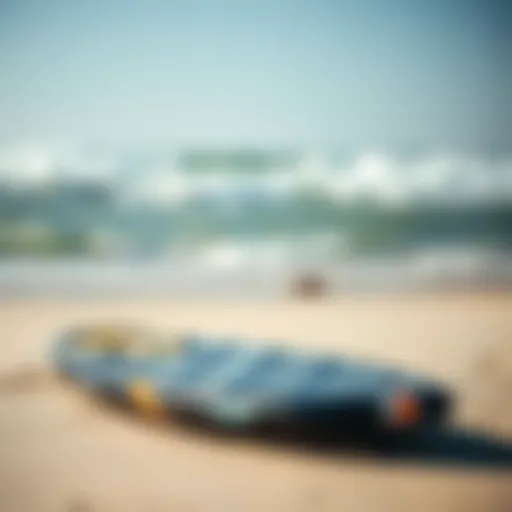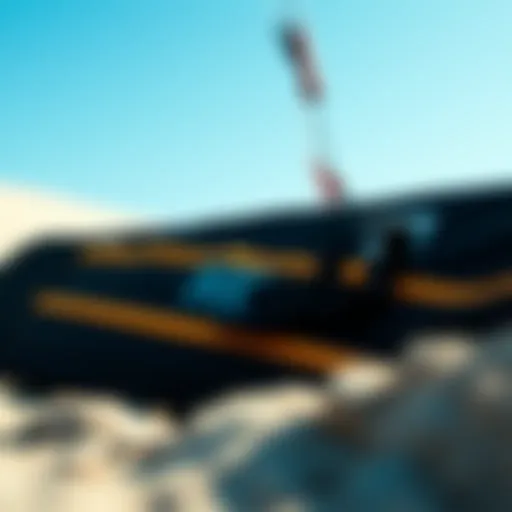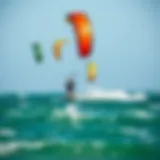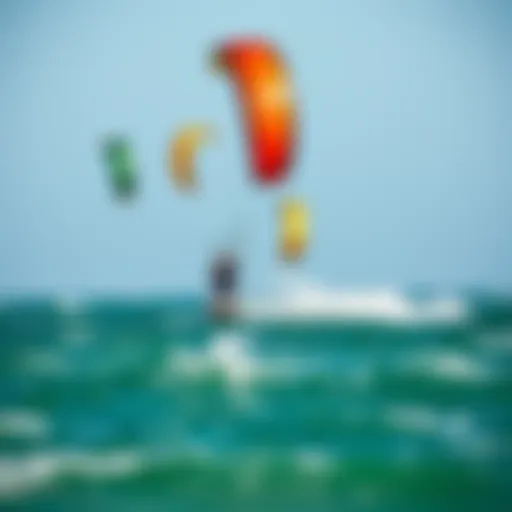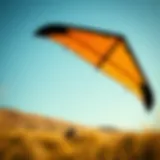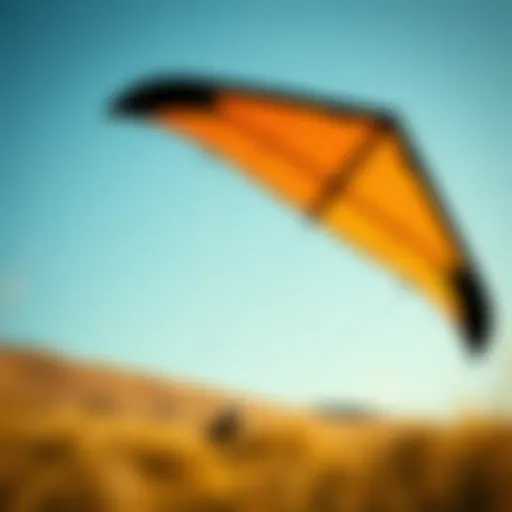Kiteboarding in Key West: The Ultimate Guide
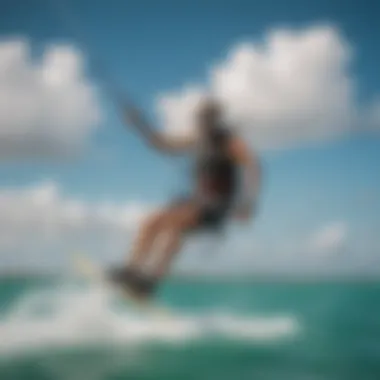

Intro
Kiteboarding in Key West is not just a sport; it's a thrilling dance with the wind and water, promising exhilaration that few activities can match. Nestled between the Atlantic Ocean and the Gulf of Mexico, this picturesque locale boasts ideal kiteboarding conditions for enthusiasts of all levels. From the gentle breezes that sweep across the warm waters to the vibrant local culture celebrating the sport, every aspect of kiteboarding here invites adventure.
Whether you’re eyeing to embark on your first session or you’re a seasoned kiteboarder seeking a new challenge, understanding the nuances of gear, techniques, and local insights is crucial. This guide aims to provide a roadmap through the multifaceted world of kiteboarding in Key West, lending clarity to both novices and experienced riders alike.
Strapping your feet onto a board and soaring across the waves can come with its share of challenges, yet the joys of this sport are undeniable. With a few tips and solid knowledge, the experience can indeed be one for the books. Let's dig into the essential gear you’ll need to make the most out of your time here.
Preface to Key West Kiteboarding
Kiteboarding in Key West is not just a recreational activity; it embodies a unique fusion of adventure, skill, and community. The sunny skies and vibrant waters of this tropical paradise create an ideal setting for both novice and seasoned kiteboarders. Understanding the essence of this sport in Key West is crucial—from the geographical features that influence wind conditions to the history that etched kiteboarding into the local culture. This guide aims to explore those intricacies, thereby enriching your kiteboarding experience in this picturesque location.
Geographical Overview
Key West, the southernmost point of the continental United States, is characterized by its sandy shores, crystal-clear waters, and delicate marine ecosystems. Nestled between the Atlantic Ocean and the Gulf of Mexico, it provides a unique geographical environment that shapes the kiteboarding experience. As the winds blow primarily from the east, kiteboarders enjoy consistent and reliable wind conditions year-round.
The most popular kiteboarding spots include Smathers Beach and Higgs Beach, where the shallow waters and open spaces allow for both beginners and experts to practice without the threat of large waves. The proximity of these beaches to the local amenities also ensures that adventurers can easily access shops and instructional lessons when needed. Here, the vibrant palm trees sway gently in the breeze, welcoming enthusiasts to hone their skills amid such idyllic surroundings.
Historical Context of Kiteboarding
Kiteboarding, which began to gain popularity in the late 20th century, has roots that can be traced back to various boarding sports. Its evolution into what we know today was significantly influenced by advancements in windsurfing and surfing, but it was the unique allure of kiteboarding that drew many to the sport.
Key West has become a significant hub for kiteboarding due to its favorable weather and wind patterns, along with a community that shares a passion for the sport. The local culture embraced this new wave of adventure; kiteboarding schools began to pop up, offering lessons and honing the skills necessary to navigate the waters safely. Riders often gather at the beaches to share tips and techniques, fostering a tight-knit community that thrives on both camaraderie and competition. It’s not merely about riding the waves; it’s about becoming part of a legacy that recognizes the blend of thrill and tranquility Key West offers.
"Kiteboarding is more than a sport; it's a lifestyle embraced by those who appreciate the beauty of the ocean and the thrill of the wind."
Understanding these foundational elements allows kiteboarding enthusiasts to truly appreciate what makes Key West a preferred destination. It gives context to the sport and helps riders navigate their personal journey, whether they're just starting out or polishing their advanced moves.
Understanding Key West's Wind Conditions
Understanding the wind conditions in Key West is like knowing the heartbeat of kiteboarding. The winds dictate how exhilarating your ride can be and mastering this aspect can greatly influence not only your experience but also your skill development. Kiteboarders, whether they're amateurs or veterans, need to pay attention to the wind patterns. This knowledge helps in choosing the right time and techniques to maximize fun while ensuring safety.
Seasonal Wind Patterns
The wind in Key West tells a story through the seasons. During the winter months from November to April, the northeast winds tend to dominate, often averaging between 15 to 25 knots. These smooth and consistent winds create ideal conditions for beginners and seasoned kiters alike who want to sharpen their skills.
Once summer rolls around, things tend to get a bit trickier. Winds shift to the southeast and can vary more in strength and direction. This can make the waters a bit choppy, which is not necessarily a bad thing – experienced riders often revel in such conditions.
Take note of the season you plan to visit:
- Fall (September to October): As the summer winds settle, expect changing patterns with moderate breeze. Good for beginners.
- Winter (November to April): Predominantly strong northeast winds which are great for all skill levels.
- Spring (April to June): Inconsistent, allowing for both calm mornings and windy afternoons, offering unique opportunities.
- Summer (July to August): South winds bring variability which can be both a challenge and a chance for thrill-seekers.
"Knowledge of local wind conditions is not just a guideline; it's an unspoken rule of kiteboarding in Key West."
Best Times to Kiteboard
Timing your kiteboarding adventures in Key West is essential to optimize your experience. Generally, the prime time for kiteboarding is during the winter months. The prevalence of consistent northeast winds creates perfect riding conditions, making it a popular choice for both locals and visitors.
In specifics, late morning until mid-afternoon generally provides the best wind consistency, thanks to the daily trends where winds pick up. Morning conditions tend to be calmer, favoring beginners wanting to learn in a less turbulent environment, while the afternoon often sees stronger winds that experienced riders seek.
Embrace midweek days, as weekends can attract larger crowds. However, kiteboarding events do create a vibrant atmosphere should that be what you want to experience. No matter when you decide to take to the waters, staying aware of local wind reports is invaluable. Logs from local schools and weather stations can offer up-to-date conditions, helping you make informed decisions about your ride.
The essence of kiteboarding in Key West lies in respecting weather wind patterns; it’s the guiding compass for those searching for adventure on the waves.
Essential Equipment for Kiteboarding
When it comes to kiteboarding, having the right equipment is absolutely crucial. Whether you're a newcomer or a seasoned pro looking to polish your skills, the gear you choose directly affects your experience on the water. The right kite, board, and safety gear contribute not only to performance but also to your overall safety.
Equipping yourself properly can mean the difference between an exhilarating ride and a frustrating tumble. Here’s a more detailed look at the essential elements of kiteboarding equipment that every rider should consider.
Types of Kites: Which One to Choose?
Selecting the right kite can feel a bit like finding a needle in a haystack given the myriad of options available. Different types of kites cater to various conditions and riding styles. Most riders rely on two main types: C-kites and bow kites.
- C-kites are favored by freestyle enthusiasts due to their precise control and strong pull, making them ideal for executing tricks and airtime.
- Bow kites, on the other hand, are known for their ease of use and versatility in various wind conditions. They're great for beginners, offering a spacious wind range and a forgiving nature when it comes to mistakes.


Ultimately, your choice should hinge on your skill level, the riding conditions, and personal preferences. For instance, a smaller kite might suit a light wind day while a larger one takes the reins when the breezy conditions kick in.
Boards: A Breakdown of Options
The board you ride is just as vital as the kite itself, offering you the right balance and speed for your style. When evaluating board options, consider the following types:
- Directional Boards: Designed primarily for wave riding, these boards provide excellent grip and maneuverability, ideal for those looking to carve through the waves.
- Twin Tip Boards: These are the most common boards used by freestyle riders. They allow for riding in both directions and cater to various skill levels, making them a versatile choice for returning kiteboarders.
- Freestyle Boards: These boards are built for performance, focusing on fast speeds and high jumps. They generally have stiffer flex, providing greater control for tricks.
The nuances between these boards can change your riding experience drastically. It's worth taking some time to demo a few boards before making a purchase, as personal comfort can lead to better performance.
Safety Gear: A Necessary Investment
Safety should never take a back seat in kiteboarding. The sport has its risks, and equipping yourself with the proper safety gear is as important as choosing the right kite or board.
Key safety items include:
- Harness: A well-fitted harness not only secures your connection to the kite but also distributes the pull across your body, minimizing discomfort.
- Helmet: Protecting your head with a sturdy helmet is a must, especially in busy spots where collisions can occur.
- Impact Vest: An impact vest provides additional flotation and protection for your torso. It's valuable in case of hard landings or wipeouts.
- Safety Leash: This is critical for ensuring that your kite remains within reach, reducing the risk of runaway kites amid gusty conditions.
Investing in these items might seem daunting financially, but the peace of mind they provide while riding is well worth it. Ultimately, being proactive about your safety can lead to a more enjoyable and worry-free kiteboarding experience.
Remember, it’s an investment not just in gear, but in your personal safety and long-term enjoyment of the sport.
Skill Development in Kiteboarding
In the world of kiteboarding, skill development stands as a pivotal pillar for riders at all levels. Nurturing one’s kiteboarding abilities not only enhances the overall experience but also ensures safety and longevity in the sport. The journey of learning unfolds in distinct stages, each tailored to address specific needs and skill sets. The right coaching and commitment can turn a timid novice into a confident kiteboarding enthusiast capable of tackling advanced maneuvers and enjoying exhilarating rides on the water. Let’s delve into the different stages of skill development and their respective importance.
Beginner Lessons: Getting Started
For those stepping into the thrilling realm of kiteboarding, beginner lessons offer an essential foundation. During these lessons, students learn about the components of the kite, proper equipment setup, safety protocols, and basic flying techniques. Most instructors begin by breaking down the fundamentals into digestible pieces, focusing on key elements such as:
- Understanding the Wind: Learning how to read wind patterns and wind windows is crucial. This skill determines when and where kiteboarding can take place effectively.
- Kite Control: Handling a trainer kite on land helps beginners grasp the dynamics of wind and how to maneuver the kite. This practice builds confidence before transitioning to water.
- Body Positioning: Learning how to position oneself correctly on the board ensures proper stance, balance, and reduced risk of injury.
Unquestionably, these foundational lessons build a sense of safety and competence that translates into more enjoyable experiences on the water.
Intermediate Tricks and Techniques
Once the basics are down pat, kiteboarders naturally progress to intermediate tricks and techniques. Here, the focus shifts towards refining skills and learning to execute more complex maneuvers. At this level, riders often explore:
- Transitions: Learning how to shift from one direction to another while maintaining speed is often a first step towards mastering freestyling.
- Jumping Techniques: Gaining enough lift to jump becomes a thrilling endeavor. Techniques may include simple jumps to more advanced moves like grabs and rotations.
- Use of Smaller Kites: Intermediate riders often experiment with smaller kites for improved handling and dynamic flying, fostering a stronger connection with the wind.
Mastering these skills not only elevates performance but can also invigorate the rider’s passion for the sport, making each session on the water more exhilarating than the last.
Advanced Maneuvers for Experts
For the seasoned kiteboarder, the journey doesn't stop at intermediate skills. Instead, the exploration extends into advanced maneuvers that push the envelope of what's possible. At this stage, riders typically focus on:
- Complex Tricks: This includes rotations, flips, and spins that require muscle memory, timing, and an innate understanding of the kite's behavior in various wind conditions.
- Riding in Different Environments: Experts often seek to ride in diverse situations, from choppy ocean waves to flat water lagoons, adapting their skills to different conditions.
- Performance Optimization: Many advanced riders invest time in understanding gear customization, tweaking their equipment to suit personal style and preferences.
Adventurous as it is technically demanding, mastering advanced maneuvers reinforces a rider's place within the kiteboarding community, often leading to participation in competitions and exhibitions.
"The beauty of kiteboarding lies not just in the ride, but in the dedication to perfect one’s skills. Every jump, every maneuver tells a story of progress and passion."
In summary, skill development in kiteboarding is a journey that mirrors personal growth and adventure. With each lesson and every trick learned, riders not only enhance their capabilities but also deepen their connection to this exhilarating sport.
Safety Protocols in Kiteboarding
Kiteboarding offers thrill and excitement, yet the sport inherently carries risks. Safety protocols are the backbone for any rider. Understanding and adhering to these practices not only enhances safety but also nurtures a more enjoyable experience in the waters of Key West. Riders should internalize these protocols as second nature. It’s about being prepared and proactive, ensuring that the joy of kiteboarding doesn’t come at the expense of safety.
Understanding Risk Factors
In the exhilarating realm of kiteboarding, risk factors abound. The winds that lift you into a state of bliss can just as easily turn turbulent. Awareness of these risks is key to mitigating them. Here are significant factors to consider:
- Weather Conditions: Changes can be rapid in coastal environments. Knowing the local weather patterns, including big wind shifts and storms, is crucial. Checking forecasts and conditions right before setting out is non-negotiable.
- Equipment Failure: Kite and board integrity is essential. Regular inspections can save you from a nasty spill. Look for wear and tear, especially in lines and kites.
- Water Hazards: Hazards under the surface or waves can surprise even seasoned riders. Familiarize yourself with the area you plan to ride.
- Inexperienced Riders: Collisions with others are a real threat. Awareness of one's surroundings is vital, as is communicating effectively with fellow kiteboarders.
Understanding these risk factors allows riders to prepare effectively, which is a step towards ensuring not just their safety but also that of others.
Emergency Procedures for Riders
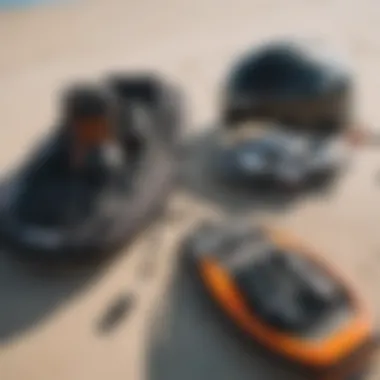

Incidents may arise despite the best precautions, making it essential to have emergency procedures in place. Here’s a rundown on what every kiteboarder should know:
- Emergency Signals: Knowing how to communicate distress is critical. A simple hand signal can alert fellow kiters. Familiarize yourself with the universal distress sign: raising one arm above your head can signify issues.
- Self-Rescue Techniques: Understanding how to safely get yourself to shore makes a world of difference in emergencies. Practice the "turtle position" (a balance method of keeping the kite upside down) to reduce drag when winds pick up.
- Navigating Tow and Rescue: Know who can assist if you find yourself in tricky waters. Ideally, local kite schools will have safety boats or personnel able to swoop in and help.
- First Aid Awareness: Having basic first aid knowledge is vital. Ride with someone who can at least stop bleeding or recognize heat exhaustion or hypothermia symptoms. It’s better to be prepared than caught off guard.
Remember: Should you find yourself in a situation where immediate evacuation is necessary, keep calm. Panicking can worsen the situation.
Overall, having these emergency procedures at your fingertips can mean the difference between a simple mishap and a more serious incident. Always prioritize understanding risk factors, so when those unexpected moments show up, you're ready to tackle them with confidence.
Local Kiteboarding Schools and Instruction
Kiteboarding is a thrilling sport, but venturing into it without proper instruction can be like sailing a ship without a compass. Local kiteboarding schools in Key West play a vital role in ensuring that novices get a safe and educational start, while also aiding seasoned riders in honing their skills. Apart from teaching essential techniques, these schools foster a sense of community and provide a structured learning environment that enhances safety and fun on the water.
Finding the Right School
When deciding on a kiteboarding school, it's important to consider various factors to ensure the best learning experience. Here are a few key aspects to weigh:
- Location: Proximity to good kiteboarding spots is important. Schools located near beaches with consistent wind and ample space tend to provide better training environments.
- Reputation: Do your homework! Look for reviews and testimonials from previous students. There’s a wealth of information available on platforms like Reddit or Facebook, where you can find honest opinions and experiences from fellow riders.
- Course Options: Some schools offer tailored packages that match your skill level and learning pace. Whether you are looking for group lessons or one-on-one instruction, the right school should cater to your specific needs.
- Facilities: Check out the equipment they use. Modern, well-maintained gear can make a big difference, especially for beginners who may still be mastering basic maneuvers.
- Support Services: Consider if the school provides additional services like gear rental, storage facilities, and safety briefings. This can enhance your overall experience and make things easier logistically.
Instructor Qualifications to Consider
The competence of instructors can significantly enhance the learning experience. Here are some qualifications to look out for when evaluating potential kiteboarding instructors:
- Certifications: Instructors should hold relevant certifications from recognized kiteboarding organizations. This ensures they have mastered safety protocols and teaching methods necessary for effective instruction.
- Experience Level: Practical experience counts. Instructors who have participated in competitions or have prolonged teaching experience can offer insights that a newcomer might not provide.
- Teaching Style: Every teacher has a unique approach. Some may be more hands-on, while others provide verbal cues. Finding an instructor whose style aligns with your preferred learning method can make a world of difference.
- Communication Skills: An instructor's ability to convey complex concepts in simple terms can greatly ease the learning process. They should be approachable and willing to answer questions thoroughly.
"Choosing the right instructor can be the difference between joyfully riding the waves and struggling to stay afloat."
- Safety Awareness: A good instructor prioritizes safety above all. They should be able to teach you how to assess risks related to both environmental conditions and equipment use, ensuring you're well-prepared for the kiteboarding experience.
Kiteboarding Events and Competitions
Kiteboarding events and competitions play an essential role in the activity's community within Key West. These gatherings not only showcase remarkable skills and talents but also foster a sense of camaraderie among kiteboarders of all levels. Engaging in competitions can enhance one's own riding abilities by providing motivation and inspiration. It’s also a chance to connect with others who share the same passion. By participating in or attending these events, kiteboarders can experience the thrill of friendly competition while learning new techniques and strategies from seasoned athletes.
Annual Kiteboarding Championships
Every year, Key West hosts the Annual Kiteboarding Championships, drawing competitors from far and wide. This is not just a contest of skill; it's a spectacle that highlights the unity of the kiteboarding community. Participants take to the water to showcase their acumen in various disciplines, from freestyle tricks to racing.
Here are a few key highlights about the championships:
- Diverse Categories: The event usually features different categories that suit varying skill levels, making it welcoming for both amateurs and seasoned pros.
- Prizes and Sponsorship: Competitors can win attractive prizes and gain sponsorship opportunities, which can be a game-changer for aspiring professional riders.
- Vendor Area: Beyond the contest itself, a vendor area brims with the latest gear and accessories, letting attendees discover new products that fit their kiteboarding needs.
Although competing can be nerve-wracking for some, it’s a fantastic atmosphere filled with excitement. The beaches become alive with the colorful kites that dot the sky, and the cheers from the crowd create an electrifying ambience.
Local Meetups and Community Events
Local meetups and community events serve as an excellent platform for enthusiasts to blend informal practice with networking opportunities. These gatherings emphasize the importance of sharing knowledge and experiences among kiteboarders. Whether it's a casual beach day or a themed gathering, these events encourage riders at all levels to meet, ride, and exchange stories and tips.
Some notable aspects of local kiteboarding meetups include:
- Skill Sharing: Participants can benefit from informal mentorship opportunities, where experienced riders share their insights and trick tips.
- Social Atmosphere: These events create a relaxed ambiance where individuals can bond over shared interests, enhancing both the sport’s community aspect and individual enjoyment.
- Beach Cleanups and Local Advocacy: Many local events focus on environmental stewardship, such as beach cleanups, promoting a sustainable approach to kiteboarding.
"Engagement in local kiteboarding events does not only build individual skills but also deepens one's connection with the riding community, helping each other rip through the winds of the beautiful Key West waters."
With both competitions and local meetups, Key West kiteboarding enthusiasts can enhance their experiences, elevate their skills, and contribute to a supportive and vibrant community.
Exploring the Cultural Aspects of Kiteboarding
Kiteboarding in Key West isn’t just a sport; it’s a way of life for many. The community that surrounds this exhilarating activity plays a pivotal role in shaping its identity and fostering connections among enthusiasts. Understanding the cultural elements of kiteboarding reveals layers of passion and camaraderie that can enhance one's experience, whether you're a rider or a spectator.
The Community of Kiteboarders
In Key West, kiteboarding is more than a leisure activity. It binds together a diverse group of individuals from various backgrounds, united by their love for the waves and winds. This community thrives on shared experiences that range from exhilarating rides to serene sunset sessions over the horizon.
- Inclusivity: Kiteboarders in this region are known for their welcoming nature. Whether a novice or a seasoned pro, anyone can join in the fun. Local kiteboarding schools often host beginner days, creating opportunities for newcomers to learn from seasoned participants.
- Social Events: Regular social gatherings are held throughout the year, from informal beach meetups to organized competitions. These events are perfect for building friendships and sharing tips. The environment is filled with laughter, stories, and, sometimes, friendly banter about who catches the biggest air.
- Online Presence: Social media groups and forums, such as Reddit communities or Facebook groups, have also propelled this community forward. Riders share their moments and photos, sparking discussions about gear choices, techniques, and local weather patterns.
Together, these factors cultivate a vibrant atmosphere where kiteboarders can exchange knowledge and celebrate their mutual passion. It’s within this cultural framework that kiteboarding becomes more than just an activity; it transforms into a lifestyle.
Stories from Local Riders


What resonates most vividly within the kiteboarding community are the personal narratives that shape its spirit. Local riders have a rich tapestry of stories that not only inspire others but also reflect the challenges and triumphs they encounter on the water.
- Inspirational Journeys: Many riders start from modest beginnings, facing fears that come with strapping on a kite for the first time. For instance, a local rider might share a tale about struggling to master a turn, only to find their rhythm during a sunset session, creating an unforgettable moment.
- Camaraderie Building: These stories often center around bond-building experiences. One might recount a time when a fellow rider helped them recover a lost kite at sea. Moments like these create lasting friendships, transcending the sport itself.
- Environmental Awareness: As riders become more attuned to the natural world, many share their experiences about how kiteboarding has sparked a commitment to environmental conservation. A rider may detail their initiative to organize beach clean-ups, blending their love for the sport with a passion for preserving the beauty of Key West.
"Kiteboarding opened my eyes to the wonders of nature. It’s impossible not to appreciate our surroundings when you’re flying above them."
This sense of community and shared experiences enriches the cultural landscape of kiteboarding in Key West, making it a special place for enthusiasts of all skill levels. The narratives of local riders not only celebrate the sport but also unearth deeper values about connection, perseverance, and environmental stewardship.
Challenges of Kiteboarding in Key West
Kiteboarding can be a thrilling adventure, but it also presents its share of challenges, particularly in a unique environment like Key West. As kiteboarders venture into the turquoise waters, understanding the potential hurdles can significantly enhance their experience. Safety is paramount. That's where talking about environmental concerns and weather-related challenges comes in—keeping riders informed and prepared ensures not only their safety but also the preservation of this beautiful locale for future enthusiasts.
Environmental Concerns
Kiteboarding inherently interacts with nature, and Key West's delicate ecosystems face certain risks associated with the sport. Riders must be aware of local wildlife, as some species are vulnerable and could be easily disturbed by the presence of boards and kites.
- Coral Reefs and Sea Life: Key West is home to rich coral reefs that serve as habitats for diverse marine life. Kiteboarders should take care to avoid these areas, which can be damaged by carelessness. A common recommendation is to limit riding to established zones, which helps protect these underwater havens.
- Coastal Erosion: Frequent activities can lead to erosion, especially in shallow water areas. It's crucial for the community to recognize the impact of heavy use on shorelines and communicate pathways to minimize disruptions. Individuals can contribute by respecting no-ride zones and participating in local clean-up efforts.
"Awareness of our surroundings can make a world of difference in preserving the natural beauty of Key West while enjoying kiteboarding."
Making informed decisions and showing respect towards the environment can create a more sustainable future for kiteboarding in the area.
Weather-Related Challenges
Weather plays a pivotal role in kiteboarding, particularly in Key West, where conditions can shift quickly. Riders should be familiar with local weather patterns to help them make smart choices.
- Wind Variability: The wind in Key West can be unpredictable, with sudden gusts or drops. As experienced kiteboarders say, the wind might be your best friend one moment and a foe the next. Monitoring wind speeds through specialized apps or local reports before heading out can save a lot of confusion.
- Storms and Squalls: Sudden storms can arise during the summer months, bringing heavy rain and powerful winds. It’s not just about rain; thunderstorms also come with lightning, posing a significant risk. Riders should always check weather forecasts and be prepared to retreat to safety at the first sign of changing conditions.
- Heat and Sun Exposure: The sun in Key West can be relentless, leading to dehydration or heatstroke if one is not careful. It's essential to hydrate regularly, wear protective clothing, and liberally apply sunscreen.
Being aware of these environmental and weather challenges can help kiteboarders in Key West navigate their adventures more safely, allowing them to appreciate the beauty and thrill of the sport without difficulty. Ultimately, kiteboarding should be about enjoyment, and preparation paves the path for positive experiences.
Future Trends in Kiteboarding
As kiteboarding continues to evolve, it becomes crucial to keep an eye on what's coming next in this thrilling sport. Staying updated can bring more than just enhancement; it can reshape how riders engage with the water and each other in Key West. In the next few paragraphs, we’ll dive into current innovations and shifts in training that are poised to revolutionize kiteboarding.
Innovations in Gear and Technology
The gear we use can make a world of difference in kiteboarding. With technology advancing at a breakneck pace, manufacturers are rolling out new innovations that significantly enhance performance, safety, and overall riding experience. Lightweight materials like advanced composites have led to biased design changes that allow for more responsive and efficient kites. These modern kites can also handle varying wind conditions better, allowing riders to exploit different atmospheric scenarios.
Another exciting trend is the integration of smart technologies into the equipment. Imagine kites equipped with sensors that track performance metrics like speed and altitude, giving riders instant feedback via apps on their smartphones. These developments enable both enthusiasts and professionals to hone their skills and optimize their performance effortlessly.
The focus on environmental sustainability is no longer a side note; brands are taking initiatives to use eco-friendly materials and production methods. Riders can now align their passion with a commitment to preserving the beautiful waters of Key West, knowing their gear is more than just effective—it's also responsible.
Changing Perspectives on Training
As kiteboarding grows, the approach to training is also shifting. Traditional methods are giving way to more personalized, flexible training regimens. Riders are increasingly turning to virtual reality platforms for pre-tutorials, allowing them to visualize tricks and techniques before hitting the waves. This not only familiarizes them with the movements but also builds muscle memory in a safe environment.
Moreover, there’s a notable rise in community-driven workshops. Riders of all skill levels are encouraged to share techniques and tips. This peer-led format not only builds camaraderie but fosters a rich learning environment where everyone can grow together.
Many instructors are now emphasizing mental strategies alongside physical skills, teaching riders how to react and problem-solve in challenging conditions. It's not just about being able to execute a perfect jump anymore; it’s also about understanding the dynamics of the sport and the environment. This holistic perspective is helping elevate kiteboarding as not just a sport, but a way of life that requires both physical prowess and mental acuity.
"As the sport evolves, our approach to training and technology needs to grow along with it. The future looks bright for kiteboarding enthusiasts, with innovation leading the way forward."
The End and Final Thoughts
Kiteboarding in Key West is not just a sport; it's an experience that resonates with the unique blend of nature, community, and adventure. Through this guide, we've traversed the essential elements that contribute to a fulfilling kiteboarding journey. Understanding the geographical attributes and wind conditions gives beginners and seasoned riders alike a solid basis to plan their outings. Moreover, knowing what equipment to procure ensures that each session is not only enjoyable but also safe.
Engagement in skill development is key for progress on the water. Our insights into local schools and instruction offer pathways to mastery and create opportunities to connect with fellow enthusiasts. In addition, being part of the vibrant kiteboarding community in Key West fosters friendships and camaraderie that enhance the overall experience.
Considering the balance between enjoyment and safety cannot be overstated. Riders must be aware of environmental factors, risks, and emergency protocols, which are detailed throughout this article. Lastly, our focus on sustainability reflects the growing recognition of our duty to protect these natural resources for future generations.
"Kiteboarding is more than just catching the wind; it’s about embracing the elements and thriving among nature's wonders."
Summarizing Key Insights
- Geographical Understanding: Key West offers ideal wind patterns that can make or break a kiteboarding experience, aligning with favorable seasonal conditions.
- Equipment Essentials: Choosing the right kite and board enhances performance; hence, investing in quality gear is essential.
- Skill Growth: Whether you’re starting or an experienced rider, there are numerous local schools available to sharpen your techniques.
- Community Connection: The local kiteboarding culture provides opportunities to meet others and share experiences, enriching the sport.
- Safety as Priority: Understanding the risks involved ensures you can enjoy your time on the water while staying safe.
- Sustainable Practices: As we enjoy the sport, considerations for the ocean and environment should guide our actions.
Encouraging a Sustainable Kiting Future
As kiteboarders, we have the privilege of enjoying some of the most beautiful waters that nature has to offer. However, this comes with a responsibility. By fostering a sustainable kiting culture, we can ensure the preservation of these precious resources for years to come. Here are some actionable steps:
- Follow Local Regulations: Respect designated areas for kiteboarding to prevent ecological disturbances.
- Educate Others: Share knowledge about the environmentally friendly practices among peers and newcomers.
- Participate in Clean-ups: Join local efforts to clean and protect beaches and waters – it’s good for the environment and community spirit.
- Choose Eco-Friendly Gear: Look for brands that prioritize sustainability in their manufacturing processes.
- Spread Awareness: Use social platforms to promote responsible kiteboarding conduct and highlight the importance of marine conservation.
Ultimately, kiteboarding should inspire us not only to ride the waves but also to ride them responsibly. By embracing sustainability, we enrich our experiences and ensure that Key West remains a kiteboarding paradise for generations to come.





